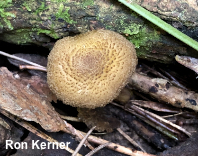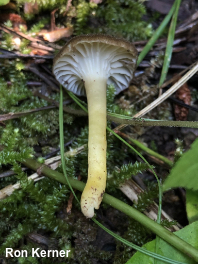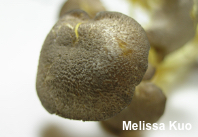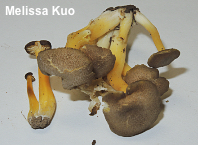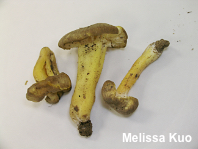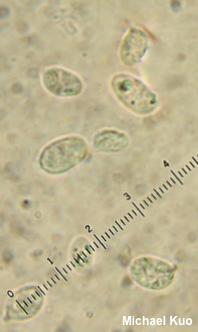| Major Groups > Gilled Mushrooms > Pale-Spored > Waxy Caps > Hygrocybe caespitosa |

|
Hygrocybe caespitosa [ Basidiomycota > Agaricales > Hygrocybaceae > Hygrocybe . . . ] by Michael Kuo The cap of Hygrocybe caespitosa is brownish to yellowish and covered with small, dark brown scales, making it an atypical waxy cap. However the thick, waxy gills and the smooth, hollowing stem are more "waxy-cap-ish," as are its microscopic features (including its long basidia and smooth, ellipsoid spores). Hygrocybe caespitosa is actually very similar to the bright orange-red Hygrocybe squamulosa, if you ignore the colors and focus, instead, on textures and stature. Look for Hygrocybe caespitosa in the Appalachian region's hardwood and conifer forests. Hygrophorus caespitosus is a synonym. Thanks to Ron Kerner for documenting, collecting, and preserving Hygrocybe caespitosa for study; his collection is deposited in The Herbarium of Michael Kuo. Description: Ecology: Precise ecological role uncertain (see Lodge and collaborators, 2013); appearing in hardwood and conifer forests; growing alone, gregariously, or in clusters; summer; Appalachian Mountains, west to Indiana. The illustrated and described collections are from Indiana and Ohio. Cap: 1–4 cm across; convex, expanding to broadly convex, sometimes with a central depression; dry; finely scaly with brown to dark brown scales over a yellowish to orangish or yellow-brown ground color; the margin inrolled. Gills: Beginning to run down the stem; distant; short-gills present; whitish, becoming yellowish to yellow from the margin inward. Stem: 3–5 cm long; 3–7 mm thick; more or less equal; dry; bald; dull yellow to orangish yellow; hollow; basal mycelium white. Flesh: Whitish to yellowish; not changing on exposure. Odor: Not distinctive. Chemical Reactions: KOH on cap surface yellow to brownish yellow. Spore Print: White. Microscopic Features: Spores 7–11 x 4.5–6 µm; ellipsoid; apiculate; smooth; hyaline in KOH; inamyloid. Basidia 43–55 x 6–9 µm; subclavate; 4-sterigmate. Hymenial cystidia not found. Lamellar trama parallel. Pileipellis a trichoderm; elements 7.5–15 µm wide, smooth, brownish-walled in KOH; terminal cells subclavate to cylindric with rounded apices; some aggregations of tightly packed elements (representing scales) rising higher than the turf. REFERENCES: W. A. Murrill, 1914. (Hesler & Smith, 1963; Smith, Smith & Weber, 1979; Phillips, 1991/2005; Arnolds, 1995; Bessette et al., 2012; Lodge et al., 2013.) Herb. Kuo 07181503, 07181504, 08152004. This website contains no information about the edibility or toxicity of mushrooms. |
|
|
Cite this page as: Kuo, M. (2021, March). Hygrocybe caespitosa. Retrieved from the MushroomExpert.Com Web site: http://www.mushroomexpert.com/hygrocybe_caespitosa.html ©MushroomExpert.Com |
